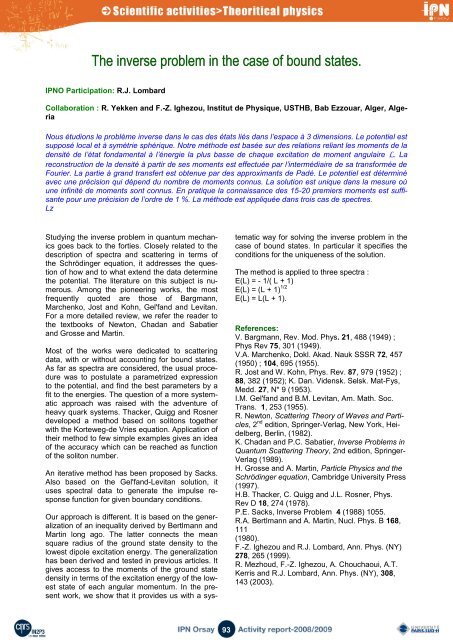exotic nuclei structure and reaction noyaux exotiques ... - IPN - IN2P3
exotic nuclei structure and reaction noyaux exotiques ... - IPN - IN2P3
exotic nuclei structure and reaction noyaux exotiques ... - IPN - IN2P3
You also want an ePaper? Increase the reach of your titles
YUMPU automatically turns print PDFs into web optimized ePapers that Google loves.
The inverse problem in the case of bound states.<br />
<strong>IPN</strong>O Participation: R.J. Lombard<br />
Collaboration : R. Yekken <strong>and</strong> F.-Z. Ighezou, Institut de Physique, USTHB, Bab Ezzouar, Alger, Algeria<br />
Nous étudions le problème inverse dans le cas des états liés dans l’espace à 3 dimensions. Le potentiel est<br />
supposé local et à symétrie sphérique. Notre méthode est basée sur des relations reliant les moments de la<br />
densité de l’état fondamental à l’énergie la plus basse de chaque excitation de moment angulaire L. La<br />
reconstruction de la densité à partir de ses moments est effectuée par l’intermédiaire de sa transformée de<br />
Fourier. La partie à gr<strong>and</strong> transfert est obtenue par des approximants de Padé. Le potentiel est déterminé<br />
avec une précision qui dépend du nombre de moments connus. La solution est unique dans la mesure où<br />
une infinité de moments sont connus. En pratique la connaissance des 15-20 premiers moments est suffisante<br />
pour une précision de l’ordre de 1 %. La méthode est appliquée dans trois cas de spectres.<br />
Lz<br />
Studying the inverse problem in quantum mechanics<br />
goes back to the forties. Closely related to the<br />
description of spectra <strong>and</strong> scattering in terms of<br />
the Schrödinger equation, it addresses the question<br />
of how <strong>and</strong> to what extend the data determine<br />
the potential. The literature on this subject is numerous.<br />
Among the pioneering works, the most<br />
frequently quoted are those of Bargmann,<br />
Marchenko, Jost <strong>and</strong> Kohn, Gel'f<strong>and</strong> <strong>and</strong> Levitan.<br />
For a more detailed review, we refer the reader to<br />
the textbooks of Newton, Chadan <strong>and</strong> Sabatier<br />
<strong>and</strong> Grosse <strong>and</strong> Martin.<br />
Most of the works were dedicated to scattering<br />
data, with or without accounting for bound states.<br />
As far as spectra are considered, the usual procedure<br />
was to postulate a parametrized expression<br />
to the potential, <strong>and</strong> find the best parameters by a<br />
fit to the energies. The question of a more systematic<br />
approach was raised with the adventure of<br />
heavy quark systems. Thacker, Quigg <strong>and</strong> Rosner<br />
developed a method based on solitons together<br />
with the Korteweg-de Vries equation. Application of<br />
their method to few simple examples gives an idea<br />
of the accuracy which can be reached as function<br />
of the soliton number.<br />
An iterative method has been proposed by Sacks.<br />
Also based on the Gel'f<strong>and</strong>-Levitan solution, it<br />
uses spectral data to generate the impulse response<br />
function for given boundary conditions.<br />
Our approach is different. It is based on the generalization<br />
of an inequality derived by Bertlmann <strong>and</strong><br />
Martin long ago. The latter connects the mean<br />
square radius of the ground state density to the<br />
lowest dipole excitation energy. The generalization<br />
has been derived <strong>and</strong> tested in previous articles. It<br />
gives access to the moments of the ground state<br />
density in terms of the excitation energy of the lowest<br />
state of each angular momentum. In the present<br />
work, we show that it provides us with a sys-<br />
tematic way for solving the inverse problem in the<br />
case of bound states. In particular it specifies the<br />
conditions for the uniqueness of the solution.<br />
The method is applied to three spectra :<br />
E(L) = - 1/( L + 1)<br />
E(L) = (L + 1) 1/2<br />
E(L) = L(L + 1).<br />
References:<br />
V. Bargmann, Rev. Mod. Phys. 21, 488 (1949) ;<br />
Phys Rev 75, 301 (1949).<br />
V.A. Marchenko, Dokl. Akad. Nauk SSSR 72, 457<br />
(1950) ; 104, 695 (1955).<br />
R. Jost <strong>and</strong> W. Kohn, Phys. Rev. 87, 979 (1952) ;<br />
88, 382 (1952); K. Dan. Vidensk. Selsk. Mat-Fys,<br />
Medd. 27, N* 9 (1953).<br />
I.M. Gel'f<strong>and</strong> <strong>and</strong> B.M. Levitan, Am. Math. Soc.<br />
Trans. 1, 253 (1955).<br />
R. Newton, Scattering Theory of Waves <strong>and</strong> Particles,<br />
2 nd edition, Springer-Verlag, New York, Heidelberg,<br />
Berlin, (1982).<br />
K. Chadan <strong>and</strong> P.C. Sabatier, Inverse Problems in<br />
Quantum Scattering Theory, 2nd edition, Springer-<br />
Verlag (1989).<br />
H. Grosse <strong>and</strong> A. Martin, Particle Physics <strong>and</strong> the<br />
Schrödinger equation, Cambridge University Press<br />
(1997).<br />
H.B. Thacker, C. Quigg <strong>and</strong> J.L. Rosner, Phys.<br />
Rev D 18, 274 (1978).<br />
P.E. Sacks, Inverse Problem 4 (1988) 1055.<br />
R.A. Bertlmann <strong>and</strong> A. Martin, Nucl. Phys. B 168,<br />
111<br />
(1980).<br />
F.-Z. Ighezou <strong>and</strong> R.J. Lombard, Ann. Phys. (NY)<br />
278, 265 (1999).<br />
R. Mezhoud, F.-Z. Ighezou, A. Chouchaoui, A.T.<br />
Kerris <strong>and</strong> R.J. Lombard, Ann. Phys. (NY), 308,<br />
143 (2003).<br />
93

















